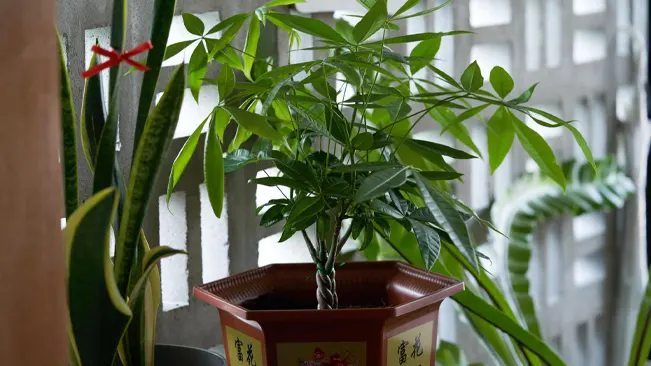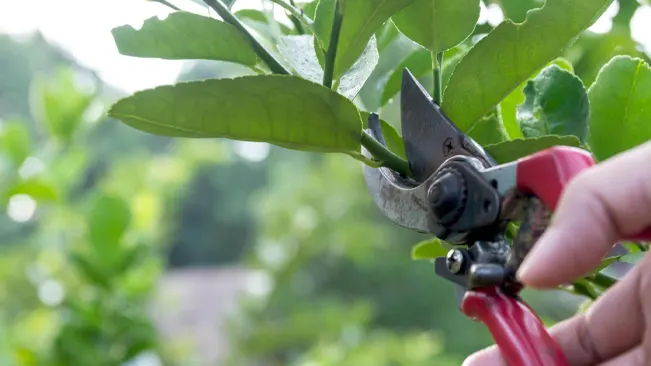How to Care for a Money Tree
- April 4, 2024
- 0 comment
Learn How to Care for a Money Tree, a plant believed to bring financial prosperity, by understanding its needs and providing the right environment for its growth.

With the right care, these plants not only enhance the aesthetic of your space but are also thought to bring positive energy and good luck. Their notable braided trunks and lush, green leaves are a symbol of growth and resilience, making them popular in both homes and offices.
By investing in the well-being of your Money Tree, you are, in a sense, investing in the well-being of your own surroundings, adding not just a decorative touch, but fostering a space of growth and positivity.
5 Essential Tips for Nurturing a Money Tree
Caring for a Money Tree, known for its lush foliage and braided trunk, necessitates mindful yet simple practices. Our guide, “5 Essential Tips for Caring for a Money Tree,” offers practical and sustainable strategies to nurture these treasured houseplants, ensuring they not only survive but thrive in your home environment, contributing to a harmonious and prosperous atmosphere.
1. Choosing the Right Location

Finding the perfect spot for your Money Tree is a key step in its care. These robust plants flourish in bright, indirect light — too direct, and the leaves may scorch; too dark, and growth may become stunted.
When scouting locations, seek out a place that receives plenty of natural light, such as near a north-facing window, where the sun’s rays are filtered. If direct sunlight is unavoidable, consider using a sheer curtain as a buffer to soften the intensity.
Regularly rotating your Money Tree will also encourage even growth and prevent it from leaning towards the light source. As seasons change and daylight shifts, be prepared to find a new spot to maintain the optimal light conditions your Money Tree needs to thrive.
By placing your Money Tree in its ideal location, you’re setting the stage for a healthy and vibrant plant that can enhance your space with its tropical flair and symbolic prosperity.
4 things to consider in Choosing the Right Location for your Money Tree
- Light Exposure: Money Trees prefer bright, indirect sunlight. A location near a window that offers plenty of light without direct sun exposure throughout the day is ideal.
- Room Temperature: These plants enjoy a stable, warm environment without drastic temperature changes. Avoid placing them near drafty windows or doors, or close to heating and cooling vents.
- Humidity Levels: As tropical plants, Money Trees thrive in a more humid atmosphere. A bathroom with a window or a kitchen can be a great spot, provided they also get enough light.
- Space for Growth: Money Trees can grow quite large. Choose a location that allows for vertical growth without obstructions, and consider the ease of access for watering and care.
2. Proper Watering

Adequate watering is pivotal to the well-being of your Money Tree, a plant that thrives on balance. Overwatering can lead to root rot, while under-watering can cause its leaves to wilt and brown. Here’s how to water your Money Tree the right way:
The crucial first step is to determine the dryness of the soil. Before giving your plant a drink, check that the top few inches of soil are dry to the touch. This method ensures that you’re not over-saturating the soil, which could be detrimental to your plant’s roots.
Regular monitoring is key; as seasons and indoor temperatures change, so too will your Money Tree’s watering needs. Adjust your schedule accordingly, and your Money Tree will not only survive but will prosper and grow.
This mindful approach to watering will anchor the care routine for your Money Tree, ensuring its lush, green foliage continues to symbolize prosperity and growth in your home.
4 key factors to consider in Proper Watering your Money Tree
- Soil Moisture: Before watering, check that the top 2-3 inches of the soil are dry. Over-watering can cause root rot, so it’s important that the soil isn’t constantly wet.
- Water Quantity: When you do water, ensure that the water reaches deep into the roots. The soil should be thoroughly saturated so that water runs out of the drainage holes at the bottom of the pot.
- Watering Schedule: Establish a regular watering schedule, but be flexible according to the season and the humidity levels in your home. Less water may be required in winter months when the plant is dormant.
- Quality of Water: Use room temperature water that’s been allowed to sit out overnight, which helps to dissipate any chlorine or chemicals that may be present in tap water, providing a gentler option for your plants.
3. Ideal Humidity

Money Trees, native to Central and South American swamps, thrive in environments with high humidity, which can be a challenge to replicate in a home setting. Ideally, these plants prefer humidity levels of 50-60%, which is often higher than the average indoor atmosphere.
Achieving this level of humidity is essential for the plant’s health as it encourages lush leaf growth and mimics the natural moisture level of its native habitat. Without sufficient humidity, the leaves may begin to brown at the tips and the plant can become stressed, making it more susceptible to pests and disease.
Regularly checking the humidity level with a hygrometer will help you maintain the perfect balance for your Money Tree. Seasonal changes can affect indoor humidity, so it’s important to adjust your humidity-raising strategies accordingly. During winter months when indoor air tends to be drier, your Money Tree might need extra attention. On the other hand, in the summer or in more humid climates, be cautious not to overdo it, as excessive humidity can promote fungal diseases.
4 Things to consider to ensure your Money Tree gets the Humidity it Craves
- Placement: Position your Money Tree in a room that naturally retains moisture, such as the kitchen or bathroom, provided it can still receive ample indirect sunlight.
- Humidity Trays: Create a microclimate of moisture around your plant by placing it on a tray filled with pebbles and water. As the water evaporates, it increases the humidity around the tree.
- Regular Misting: Take a more hands-on approach by misting your Money Tree’s leaves regularly. This not only boosts the humidity but also helps to keep the leaves dust-free, allowing for better photosynthesis.
- Room Humidifiers: Employing a humidifier can offer a consistent and controlled solution to the indoor humidity levels, ensuring your Money Tree remains in its ideal tropical-like conditions.
4. Temperature Considerations

Money Trees prefer a stable temperature range between 65°F to 80°F (18°C to 27°C), which is typical of their native tropical climate. Extreme temperatures can lead to stress and damage, so it’s important to avoid placing your plant near drafty windows or heat sources.
Sudden temperature drops and cold drafts are particularly harmful to a Money Tree. During winter, ensure the plant is kept away from open windows or doors that could expose it to chilly air.
Maintaining a consistent temperature helps the Money Tree to focus its energy on growth rather than survival. Fluctuations in heat, especially exposure to high temperatures, can cause leaf drop and stunt growth, so keeping the temperature steady is crucial for a thriving plant.
4 things to consider Regarding Temperature for your Money Tree
- Stable Temperature Range: Money Trees are best suited to temperatures between 65°F to 80°F (18°C to 27°C). They are not frost-tolerant and can be damaged by temperatures below 50°F (10°C), so it’s important to keep them in a consistently warm environment.
- Avoid Temperature Shock: These plants can experience shock if moved from a very warm to a very cool environment (or vice versa) too quickly. Gradual acclimation to new temperatures is key if you need to move your plant.
- Protect from Direct Heat: Keep Money Trees away from direct sources of heat, such as radiators, heat vents, and stoves. Excessive heat can dry out the plant too quickly and cause stress.
- Cool Nights: While they like warm days, Money Trees can benefit from slightly cooler temperatures at night, within the range of 60°F to 70°F (15°C to 21°C). This drop in temperature can simulate their natural environment and may promote better growth.
5. Feeding and Pruning

Fertilizing your Money Tree is crucial for its growth and health, especially during the growing seasons of spring and summer. Use a balanced, water-soluble fertilizer once a month to provide essential nutrients without overfeeding.
Regular pruning helps maintain the shape of your Money Tree and encourages new growth. Remove any yellow or dead leaves and trim back overgrown branches to keep the plant looking its best.
The best time to prune a Money Tree is in the spring or early summer when the plant is actively growing. Use clean, sharp scissors or pruning shears, and make cuts just above leaf nodes to encourage bushier growth.
4 things to consider in Feeding and Pruning your Money Tree
- Nutrient Requirements: Money Trees benefit from a balanced, water-soluble fertilizer. Apply it once a month during the growing season (spring and summer) but reduce feeding in fall and winter when growth slows down.
- Avoid Over-Fertilizing: Be cautious not to overfeed your Money Tree, as too much fertilizer can lead to salt accumulation in the soil, which can burn the roots and damage the plant. Always follow the recommended dosage on the fertilizer package.
- Pruning for Shape and Health: Regular pruning is important not only to maintain the desired shape of your Money Tree but also to encourage healthy growth. Pruning helps the plant focus its energy on new growth and can prevent legginess.
- Best Time and Method to Prune: The ideal time to prune your Money Tree is in the late spring or early summer when it’s actively growing. Use sharp, clean pruning shears or scissors, and make cuts just above a leaf node or branching point. This encourages the plant to grow more branches, leading to a fuller appearance.
Conclusion
Caring for a Money Tree involves a balanced approach encompassing proper watering, adequate light, and controlled humidity and temperature. With regular feeding and careful pruning, these resilient plants not only enhance indoor spaces but also symbolize financial prosperity and good fortune. By attending to these key aspects, you ensure the growth and vitality of your Money Tree, making it a cherished part of your home or office.
Frequently Asked Questions (FAQs)
- How often should I water a Money Tree?
- Water your Money Tree when the top 2-3 inches of soil are dry; typically, this means watering every 7-10 days.
- Water your Money Tree when the top 2-3 inches of soil are dry; typically, this means watering every 7-10 days.
- What kind of light does a Money Tree need?
- Place your Money Tree in bright, indirect sunlight; direct sun can scorch leaves, while too little light stunts growth.
- Place your Money Tree in bright, indirect sunlight; direct sun can scorch leaves, while too little light stunts growth.
- Is it necessary to prune a Money Tree?
- Pruning helps maintain shape and encourage fuller growth; trim as needed, especially in spring or summer.
- Pruning helps maintain shape and encourage fuller growth; trim as needed, especially in spring or summer.
- How do you repot a Money Tree?
- Repot every 2-3 years in spring; choose a pot 2-3 inches larger in diameter with good drainage.
- Repot every 2-3 years in spring; choose a pot 2-3 inches larger in diameter with good drainage.
- Can a Money Tree survive in low light?
- While it prefers bright light, a Money Tree can adapt to low-light conditions, though it may grow slower.
- While it prefers bright light, a Money Tree can adapt to low-light conditions, though it may grow slower.
- Should I mist my Money Tree?
- Misting helps increase humidity, beneficial for Money Trees, but don’t overdo it to avoid fungal issues.
- Misting helps increase humidity, beneficial for Money Trees, but don’t overdo it to avoid fungal issues.
- What temperature is best for a Money Tree?
- Keep it in 65-80°F (18-27°C); protect from drafts and extreme temperatures to prevent stress.
- Keep it in 65-80°F (18-27°C); protect from drafts and extreme temperatures to prevent stress.
- How do I know if I’m overwatering my Money Tree?
- Signs of overwatering include yellowing leaves and soft, mushy stems; let soil dry out between waterings.
- Signs of overwatering include yellowing leaves and soft, mushy stems; let soil dry out between waterings.
- Can Money Trees be kept outdoors?
- They can, in warm climates; protect from direct sun and bring indoors if temperatures drop below 50°F (10°C).
- They can, in warm climates; protect from direct sun and bring indoors if temperatures drop below 50°F (10°C).
- Why are the leaves of my Money Tree turning yellow?
- Yellow leaves can be due to overwatering, poor drainage, or lack of nutrients; adjust care accordingly.

Charles Hayes
Forestry AuthorI'm Charles Hayes, I bring over 15 years of specialized expertise in landscaping and woodworking, blending artistic design with sustainable environmental stewardship. My career, fueled by a profound passion for the natural world, encompasses extensive education and hands-on experience in creating harmonious, eco-friendly outdoor spaces and responsibly managing forest resources. Recognized for my professional standing, I am committed to continuous learning and certification in cutting-edge practices. My expertise is not only reflected in my work but also in my contributions to community projects, educational workshops, and collaborations with industry leaders. As an authoritative voice in my field, I strive to share knowledge and promote environmentally conscious approaches, making me a trusted resource in landscaping and forestry.













Leave your comment